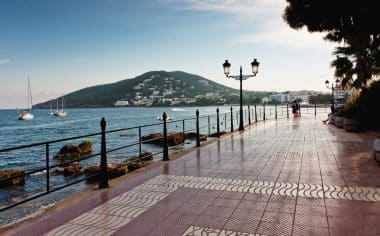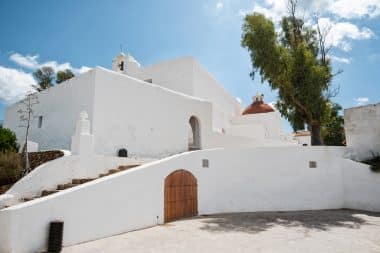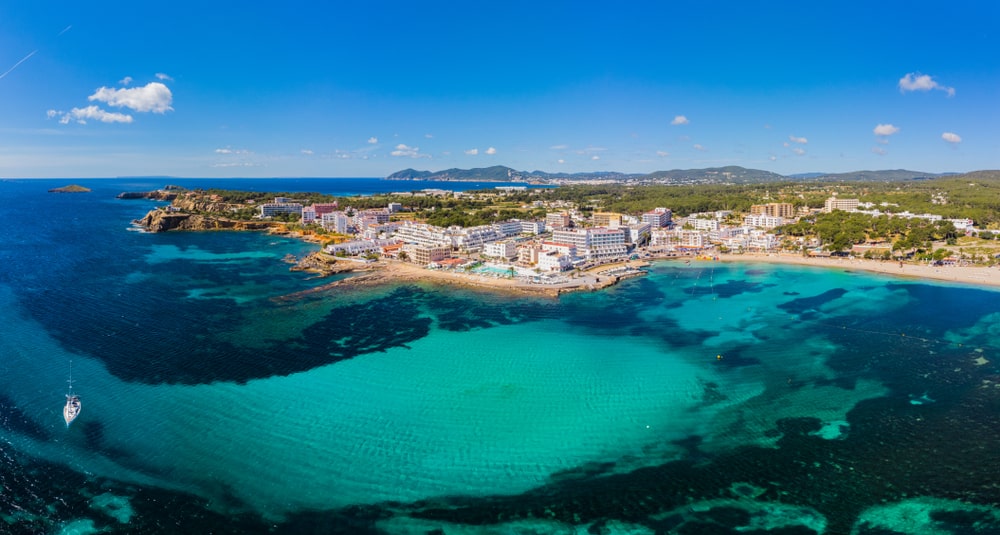The municipality of Santa Eulalia del Río (Santa Eulària des Riu) on Ibiza , which currently has a good 40,000 inhabitants in almost two dozen districts and partly widely scattered hamlets, covers an area of almost 154 km² in the eastern part of the Balearic island of Ibiza in the west of the Mediterranean.
The sophisticated marina and picturesque beaches attract many holidaymakers

The town is located on a wide bay with the headland of Punta Arabí at the eastern end and about 15 kilometres northeast of Ibiza Town. A nationally and internationally known crowd puller is the modern marina Port Esportiu with many shops, bars and restaurants. We currently recommend that you wear an FFP-2 mask inside the shops. The town has the beautiful, clean and well-maintained beaches of Cala Espart, Canal d’En Martí and Es Caló de S’Algar, which are ideal for families with children. At the western end of the bay rises the striking and surrounding landscape clearly dominating Puig d’en Fita, which is extensively built up with apartments, hotels and holiday homes and is illuminated by their lights at night.
The very fertile area was already coveted by the Moors as a cultivation area
At the time of the Moorish-Muslim rule over the archipelago and almost all of Spain (“al-Andalus”) from the 8th to the 15th century, this water-rich and fertile area was known as the “Xarc” due to the only river in Ibiza (“Riu de Santa Eulàlia”) that flows into the sea here. With the conquest of the Valencian coastal plain, the Balearic Islands and Ibiza as part of the “Reconquista” by the Aragonese in the 13th century, the successive expulsion of the Muslim population and Christian resettlement took place. Members of the nobility, church and military as well as civil servants received larger plots of land, simple workers, peasants and knights tended to receive medium and small plots (“repartimientos de donadíos”). The island was divided into quarters (“cuartos”), the quarter of Santa Eulalia was awarded to the conqueror, infante and mercenary leader Pedro de Portugal (1187-1258), the feudal lord of the then bishop of Tarragona, Guillermo de Montgrí ((1200-1273). Later, the King of Aragon, James I, acquired the ownership rights from him, whereupon the entire area became known as the “King’s Quarter”.
Old bridges, mills and churches are stone testimonies to history
The Riu de Santa Eulàlia river, mentioned above, made the site important for the irrigation of crops and nurseries, as well as the operation of numerous mills. The historic windmill with round tower “Molino de Puig d’en Valls”, first mentioned in a document in 1791, made of limestone and fieldstone, can still be visited today, which was used until 1940 and extensively renovated and restored a few years ago. Another historical attraction of the municipality worth seeing is the stone bridge with three arches “Pont Vell” a little inland from the mouth that crosses the rocky valley and is said to have been built by the Romans as part of the imperial road construction program on the island between about 200 BC and 400 AD, although its earliest mention is only found in a document from 1720. The village name Santa Eulalia itself comes from a small chapel that was built immediately after the conquest around 1302 on the top of the local mountain Puig de Missa.
The village church has undergone some changes during its long existence

Since its construction in 1568, the “Església de Puig de Missa” has also stood on the same site, in the style of a typical fortified church of the era, which can only be reached via a spiral and steep path up the slope. Built on behalf of the parishioners by the Italian military designer Giovanni Battista Calvi, who was very renowned at the time, the church is a massive round bastion in the style of the many watchtowers on the island, the porch with Moorish-inspired columns and round arches, added in the 18th century, stands separately from the main building. The church, which was relatively sparsely furnished except for a gilded altarpiece from 1967, was thoroughly restored after the end of the Spanish Civil War in 1936 due to extreme damage by iconoclastic republicans. Around this church, which is clearly visible from afar and often photographed, Santa Eulalia has grown into a small town to the present day. Among the oldest buildings on site today are the “Ajuntament” (town hall) from 1795 on Plaça d’Espanya and the lighthouse from 193/14 on the uninhabited offshore island of Tagomago, which is only about 40 hectares in size.
In the town, shops and restaurants invite you to stroll and relax
During short walks in the centre of the tranquil and pleasantly quiet city, visitors and holidaymakers can stroll through the lively main street Carrer Saint Jaume and its parallel street Carrer da Sant Vincent with cosy bars, typical taverns and restaurants. The pedestrian zone and beach promenade Passeig de s’Alamera, lined with many old trees, is also atmospheric, where guests can buy jewellery and clothing at numerous market stalls in summer. At the southern end of Passeig de s’Alamera’ is the harbour front and ferry service from Santa Eulalia with great views of the bay. Since 1985, beautiful souvenirs of all kinds have also been offered at the “hippie flea market” Las Dalias in the district of San Carlos de Peralta, where concerts with bands of different genres often take place. Popular events with many locals and visitors alike are the home games of the local football club “Penya Deportiva Santa Eulària”, founded in 1935, at the Campo Municipal de Deportes stadium with space for 1,500 spectators. For excursions and beautiful bathing days by the sea, there are also nearby beaches of Cala Boix, Cala de S’Aigua Blanca, Cala Llenya, Cala Llonga, Cala Nova, Cala Olivera, Cala Pada, Cala Rotja as well as Es Figueral and Es Niu Blau.


